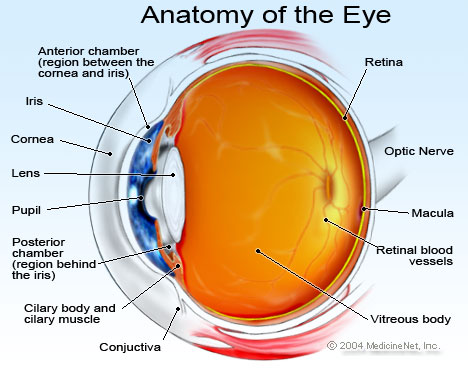A Bright Future for Eyesight

Eyesight is crucial to our independence, mobility and quality of life. However, our eyes age right along with the rest of our bodies and need special care and consideration for long-term health.
One in four people over 65 have at least early signs of age-related macular degeneration (AMD), and it is the leading cause of blindness for older adults in the world. AMD is caused by abnormal blood vessel growth behind the retina or a breakdown of the light-sensitive cells within the retina. Vision is gradually or rapidly destroyed, making it very difficult to see objects clearly, read and drive.
The part of the eye that allows you to see fine detail, the macula, deteriorates when affected by AMD. There is no pain associated with AMD. Risk factors for AMD are age, genetic markers and smoking, but researchers have made a connection with our lifestyle habits as well. Prevention is possibleBecause there is no cure for AMD, prevention and management are the only options. As we attempt to keep our bodies in shape, we should do the same with our eyes. Eyes can also benefit from a good diet and plenty of exercise, and a study of lifestyle habits indicates how true this really is.
Prevention is possibleBecause there is no cure for AMD, prevention and management are the only options. As we attempt to keep our bodies in shape, we should do the same with our eyes. Eyes can also benefit from a good diet and plenty of exercise, and a study of lifestyle habits indicates how true this really is.
Over 1,300 women were reviewed for their diet, exercise and smoking habits over a six-year period. Among the women who ate the healthiest, 11 percent had developed AMD compared to 19 percent of women who ate the worst diets. Of the women who exercised the most, one in 10 developed AMD compared to one in five with low levels of exercise. When the results were combined and no smoking was considered as well, the risk decreased more than 70 percent. This is “a particularly profound lowering of risk,” says study author, Dr. Julie Mares of the University of Wisconsin.
“Decades of studies…have all established that AMD is, in part a nutrition-responsive disease,” states Dr. Stuart Richer of the Captain James Lovell Federal Health Care Facility. “Nutritional choice, smoking cessation, and cardiovascular conditioning have myriad benefits with respect to improving blood flow that aids the delivery of nutrients and removal of waste products from the retina, as well as beneficially altering blood chemistry,” Richer adds. Therefore, AMD is associated with cardiovascular health.
A U.S. government clinical trial recently found that a mix of high-dose antioxidants can slow the progression of AMD by 25 percent if it is in the intermediate stage. Doctors can now prescribe this mix for patients. The formula is called the Age-Related Eye Disease Study Formulation (AREDS Formulation). As described by the National Eye Institute, the daily dosage amounts in the AREDS formula are**:
-
500 milligrams of vitamin C.
-
400 International Units of vitamin E.15 milligrams of beta-carotene (often labeled as equivalent to 25,000 International Units of vitamin A).
-
80 milligrams of zinc as zinc oxide, and two milligrams of copper as cupric oxide. Copper was added to the AREDS formulation containing zinc to prevent copper deficiency anemia, a condition associated with high levels of zinc intake.
** Currently, a study is underway by the National Eye Institute that may eventually alter this formula. Results have not yet been published.
The AREDS formulation is not a cure for AMD and it will not restore vision already lost from the disease. However, it may delay the onset of advanced AMD and help people who are at high risk for developing advanced AMD keep their vision.
AMD presents itself in two forms: wet and dry.
Characteristics of wet AMD, also known as advanced AMD:
-
Occurs when abnormal blood vessels behind the retina start to grow under the macula. The new blood vessels tend to be very fragile and will leak blood and fluid, which raise the macula from its normal place at the back of the eye.
-
Damage to the macula occurs rapidly.
-
Loss of central vision can occur quickly.
-
It does not have stages like dry AMD.
-
An early symptom of wet AMD is that straight lines appear wavy.
-
Treatments include:
-
Laser surgery – A laser destroys the fragile, leaky blood vessels.
-
Photodynamic therapy – A drug called verteporfin is injected into the arm. It sticks to the surface of new blood vessels. Next, a light is shined into the eye for about 90 seconds. The light activates the drug to destroy the new blood vessels.
-
Injections – Drugs are injected into the eye (anti-VEGF therapy) to block the development of a growth factor that causes the new abnormal blood vessels. Multiple injections are needed, and before each injection, the eye is numbed.
-
Characteristics of dry AMD:
-
Occurs when the light-sensitive cells in the macula slowly break down.
-
Progresses over three stages – early, intermediate and advanced.
-
Gradually, central vision becomes blurry and gets worse over time as less and less of the macula is able to function normally.
-
The most common symptom is a slightly blurred spot in the center of your vision. You may need more light for reading and have difficulty recognizing faces.
-
One of the most common early signs of dry AMD is drusen. Drusen are yellow deposits under the retina.
-
There is no current treatment for dry AMD.
Catching AMD at the first indication of a problem can help preserve your eyesight. Because no cure exists for dry AMD, discovery at the early stages is essential. Doctors usually monitor dry AMD with eye exams every six to twelve months for the first signs that it is progressing to the more dangerous wet AMD.
If you notice any changes to your vision, contact your eye care professional at once for a comprehensive dilated eye exam. Don’t assume that bad eyesight is just part of the aging process; there may be more to your altered vision than you realize.
While maintaining a healthy lifestyle has benefits to the overall condition of your body, consider how important your eyes are to your daily living and quality of life. Because there is no cure to reverse the effects of AMD, and often it goes undetected for some time, prevention by choosing the right diet and exercise plan will go a long way in keeping your eyes in focus.
# # #
Reprinted by Always Best Care Senior Services with permission from the Society of Certified Senior Advisors. The Certified Senior Advisor (CSA) program provides the advanced knowledge and practical tools to serve seniors at the highest level possible while providing recipients a powerful credential that increases their competitive advantage over other professionals. The CSA works closely with Always Best Care Senior Services to help ABC business owners understand how to build effective relationships with seniors based on a broad-based knowledge of the health, social and financial issues that are important to seniors, and the dynamics of how these factors work together in seniors’ lives. To be a Certified Senior Advisor (CSA) means one willingly accepts and vigilantly upholds the standards in the CSA Code of Professional Responsibility. These standards define the behavior that we owe to seniors, to ourselves, and to our fellow CSAs. The reputation built over the years by the hard work and high standards of CSAs flows to everyone who adds the designation to their name.
Always Best Care Senior ServicesAlways Best Care Senior Services (www.alwaysbestcare.com) is based on the belief that having the right people for the right level of care means peace of mind for the client and family. Always Best Care Senior Services has assisted over 25,000 seniors, representing a wide range of illnesses and personal needs. This has established the company as one of the premier providers of in-home care, assisted living placement assistance, and skilled home health care.
To print this article CLICK HERE





